Rajasthan Board RBSE Class 11 Biology Chapter 5 Plant Kingdom
RBSE Class 11 Biology Chapter 5 Multiple Choice Objective Questions
Question 1.
Which is prokaryotic in below given cells?
a. Green algae
b. Blue green algae
c. Brown algae
d. Red algae
Question 2.
What is obtained from Gelediumalgael
a. Iodine
b. Diatomite
c. Agar-agar
d. Bromine
Question 3.
Prof. Shivram Kashyap is:
a. Father of Indian algology
b.Father of Indian phycology
c. Father of Indian bryology
d.Father of Indian pteridophytology
Question 4.
Which of the following is bryophyte?
a. Funaria
b. Polysiphonia
c. Equisetum
d. Cycas
Question 5.
Which of the following is vascular cryptogamous?
a. Thallophyta
b. Bryophyta
c. Pteridophyta
d. Spermatophyta
Question 6.
In which plant category both the generation are autotropic and independent?
a. Algae
b. Fungi
c. Bryophyta
d. Pteridophyta
Question 7.
Which of the following is fruitless seeded plants?
a. Angiosperm
b. Gymnosperm
c. Pteridophyta
d. Phytosperm
Question 8.
What is the meaning of polypetalae?
a. Petals are free
b. Petals are fused
c. Sepals are free
d. Sepals are fused
Answers:
1. (b), 2.(c), 3.(c), 4.(a), 5.(c), 6.(d), 7.(b), 8.(a)
RBSE Class 11 Biology Chapter 5 Very Short Answer Questions
Question 1.
Undifferentiated plant body is called………….
Answer:
Thallophyta.
Question 2.
Write the name of classes in algae which do not have flagellated cells?
Answers:
Pinnularia,Navicula.
Question 3.
Write the name of two edible algae.
Answer:
Spirullina and Laminaria saccharina.
Question 4.
Which type of sexual reproduction is found in bryophyte?
Answer:
Oogamous.
Question 5.
What is peat coal?
Answer.
Sphagnum.
Question 6.
Write the name of two heterosporous pteridophytes.
Answer:
Selaginella and Salvinia.
Question 7.
Write name of two homosporous pteridophytes.
Answer:
Equisetum, Pteris.
Question 8.
Write the name of wild gymnosperm from Rajasthan.
Answer:
Pinus.
Question 9.
Which category of plants shows double fertilization and triple fusion?
Answer:
Angiosperms.
Question 10.
What is the ploidy of endosperms in angiosperms?
Answer:
Triploid.
Question 11.
Which plant gives Chilgoza?
Answer:
Cycas.
Question 12.
Which anticancer chemical is obtained from Taxus plants?
Answer:
Texol.
RBSE Class 11 Biology Chapter 5 Short Answer Questions
Question 1.
Write four characteristics of algae.
Answer:
1. Habitat : Algae are predominantly aquatic through alsofound in other habitats. They are found in fresh water,salty and marine water, in ice and in moist conditions.Sorne algae are found in unusual places also.
2. Thallus organisation: Plant body is thalloid which isnot differentiated into root, shoot and leavcs. They aremostly represented by Gametophvtic generation. Thallusmay be unicellular or multicellualr.Ch/amydomonas ismotile unicellular agla while hiorella is non motile unicellular aglac, Volvox is motile and colonial, Cladophora is filamentous etc.
3.They lack tissue differentiation and vascular tissues.
4. Cell wall of most of algae is made up of Cellulose andPectin. in Brown algae (Phaeophvceae) cell wall is madeup of Alginic acid and Fucinic acid along with cellulose. In Red algae (Rhodophyceae) cell ‘all has Polyesters suphates apart from cellulose.
Question 2.
Explain algal bloom.
Answer:
1. Water Blooms or Alga Bloom: Presence of large amounts of nutrients in waters also causes excessive growth of planktonic (free-floating) algae such as Microcystis, Oscillatoria, called an algal bloom imparts a distinct colour to the ater bodies. Algal bloomscause deterioration of the water quality and fish mortalitydue to deficiency of O2 in water. Some bloom-formingalgae are extremely toxic to human beings and animals.
2. Death of Fishes: Aphanizomenon and Microcystis are toxic for Gambusia and Crepis fish and die when they feed upon them.
3. Others: The green alga Cephaleuros virescens cuases red rust on the leaves of tea and C. coftèae causes red
ust on the leaves of coffee. Gonvaulax and Gvrnnodiniumare toxic for human. Gonyaulx releases a toxin tetrado toxin which enters in humans via fishes. It causes numbness and paralysis.
Question 3.
Draw labeled diagram of one bryophyte.
Answer:
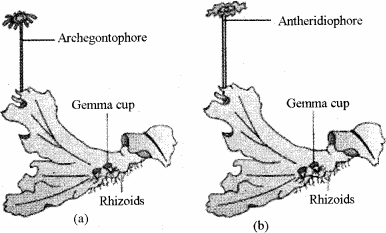
Bryophytres
Question 4.
Write the name of one aquatic bryophyte.
Answer:
Riccia fluitans.
Question 5.
Write the name of two pteridophytes.
Answer:
Salvinia, Marsilea, Azolla.
Question 6.
Explain homosporous and heterosporous spore formations.
Answer:
In majority of the pteridophytes all the spores are of similar kinds; such plants are called homosporous, eg. Equisetum, Pteris and other ferns but in 8-9 plants of genera like Selaginellaand Salvinia which produce two kinds of spores, macro (large) and micro (small) spores, are known as heterosporous.
Question 7.
Write the name of one pteridophyts which shows
Answer:
Cambium is absent in Pteridophyta so no secondary growth in Pteridophyta.
(Exception: In Isocit is and Botrychium cambium present).
Question 8.
Differentiate archigonium and oogonium?
Answer:
Oogoniumlt is sexual reproduction structure which multicellular not covered by jacketed cells Archigoniumlt is sexual reproduction structure which multicellular covered by jacketed cells.
Question 9.
Explain dioecious with monoecious term with suitable example?
Answer:
Dioecious: When male and female sex organs are present in different plant body, eg. Papaya.
Question 10.
What do you mean by gymnosperm? Explain.
Answer:
The gymnosperms are comparatively more ancient than the angiosperms in evolutionary terms.Naked seed plant does not mean that seeds of these plants do not have seed coat because in these plants seeds have seed coat. Actually Gymnosperms mean fruitless seeded plants or Phanerogams without fruits because in them fruit is absent.
Question 11.
What do you mean by alternation of generation? Explain.
Answer:
In plants, both haploid and diploid cells can divide bymitosis. This ability leads to the formation of differentplant bodies haploid and diploid. The haploid plantbody produces gametes by mitosis. This plant bodyrepresents a gametophyte. Following fertilisation the zygote also divides by mitosis to produce a diploidsporophytic plant body.
Haploid spores are producedby this plant body by meiosis. These in turn, divide bymitos is to form a haploid plant body once again. Thus,during the life cycle of any sexually reproducing plant,there is an alternation of generations between gameteproducing haploid gametophyte and sporeproducingdiploid sporophyte.
Question 12.
Write four characteristics of Gymnosperms.
Answer:
- Gymnosperms are mostly perennials, xerophytic, evergreen, arboreal and woody.
- They grow as woody trees, bushy shrubs or rarely as climbers (e.g., Gnetales).
- None of them are herbs or annuals.
- The main plant body is diploid sporophyte which is well differentiated into root, stem and leaves.
Question 13.
Write names of two aquatic and two xeric angiosperms
Answer:
Aquatic : Hydrilla, Vallisneria.
Xerophyte : Opuntia, Asperagus
Question 14.
Write the series of polypetalae and angiosperms.
Answer:
(1) Polypetalae: The flowers contain distinct non-essential whorls calyx and corolla. In the corolla petals are free.
This sub-class includes 3 series:Thalamiflorae, Disciflorae and Calyciflorae.
- Series Thalamillorae: Many stamens in the androecium. Flower is hpognous.
- Series Disciflorae: I Hvpog-nous flowers with a cushion-like disc around orbelow the ovary.
- Series Calyciflorae: Flowers epigvnous or pcrigynous. Thalamus is in theform of a cup.
(2) angiosperms: The angiosperms and the gymnosperms are part of the kingdom of plants. Angiosperms are generally considered as flowering plants while the gymnosperms are those that are known as the ancestors of angiosperms.
The major difference that often defines these plants is the seeds that it contains. The angiosperm seeds are coated within the fruits.
Question 15.
Write characteristics of monocotyledon plants.
Answer:
This group includes angiosperms in which the seed bearsonly one cotyledon.
The leaves are simple and exhibit parallel venation Closed type of vascular bundles because cambium is absent in it Vascular bundles are scaered inparenchyrna Flowers are usually trimerous Roots arc adventitious. It is divided into the following seven series.
- Microspermae : Ovary is inferior; seeds are minute and non-endospermic.
- Epigynae : Ovary inferior, seeds are large and endospermic.
- Coronarieae : Ovary superior, perianth petalloid.
- Calycinae : Ovary superior, perianth sepalloid.
- Nudiflorae : Perianth reduced or absent. Seeds are endospermic.
- Apocarpae : Carpels more than one, free, seeds are endospermic.
- Glumaceae : Perianth reduced or absent, scaly bracts present.
RBSE Class 11 Biology Chapter 5 Essay Type Questions
Question 1.
Explain classification and main characteristics of algae.
Answer:
classification of Algae: ‘Algae’ word first time used by Linnaeus (1753) but actual identification of this category of plants is done by A.L.De Jussieu (1789).Initially algae were kept in Cryptogamia by Linnaeus but latter on Eichler (1886) kept them under.
Thallophyta: Various phycologist gave elaborated classification of algae but most accepted and elaborated classification given by F. E. Fristsch in his books ‘The Structure and Reproduction of the Algae, Vol. I (1935) and Vol. II (1945).Basis of F. E. Fristsch classification of algae were types of pigments, flagella, nature of stored food material F. E. Fristsch classified algae in to 11 classes.
1.Chlorophyceae:
Commonly known as Green algae.
- Occurrence: Most forms are fresh water and few of them are marine.
- Pigments: Chief pigments are chlorophyll a and b and carotenoids (yellow pigments).
- Reserve food : Starch
- Motile cells have equal flagella (2-4).
- Reproduction: Sexual reproduction ranges from 3isogamous to advanced oogamous type. .
- Example: Chlamydomonas, Vo/vox, Chlorella, Chara,Ulothrix, Spirogyra etc.
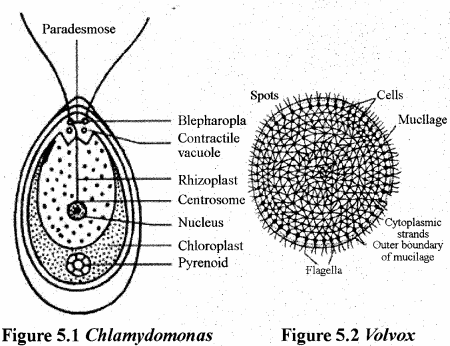
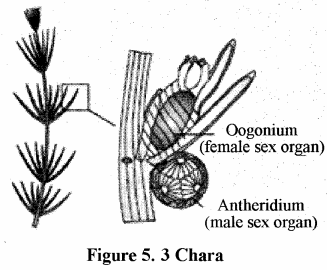
IMAGE
2. Xanthophyceae:
- Commonly known as Yellow green algae.
- Occurrence: Most forms are fresh water and few of them are marine.
- Pigments: Chief pigments are chlorophyll a and e and yellow xanthophylls pigments are found abundantly.
- Reserve food: Oil.Pyrenoids absent.
- Reproduction: Sexual reproduction rare and always isogamous.
- Example:Vaucheria ,Boutrodium.
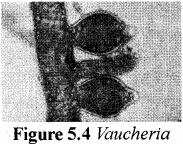
3.Chrysophyceae:
- Occurrence: Most forms occur in cold fresh water and few are marine.
- Pigments: Chief pigments are chlorophyll a and phycochrycin.
- Reserve food: Fat and leucosin.
- Example: Cryptophora.
4.Bacillariophyceae:
Commonly called Diatoms.
- Occurrence: In all kind of fresh water, sea, soil and terrestrial habitats.
- Pigments: Chromatophores are yellow or golden brown. Nature of accessory pigment is not very definite. Chief pigments are chlorophyll a and c and fucoxanthin pigments.
- Reserve food: Fat and Volutin.
- Example: Pinnularia,Navicula.
5.Cryptophyceae:
- Occurrence: Both in marine and fresh water.
- Pigments: Chromatophores show diverse pigmentation. It has Chlorophyll a and c while carotenes are a and p. Reserve
- food: Starch and Oil.
- Reproduction: Isogamous.
- Example: Crytomonas, Pheoflex.
6.Dinophyceae:
- Occurrence: Both in marine and fresh water.
- Pigments: Chromatophores show diverse pigmentation. It has Chlorophyll a and c while carotenes are a and p. Reserve
- food: Starch and Oil.
- Example.Desmocapsa, Gymnodinium.
7.Chlromonodineae:
- Occurrence: In fresh water.
- Pigments: Chromatophores are bright green in colour and contain an excess of xanthophyll and Chlorophyll a.
- Reserve food: Oil.
- Example: Trent onia
8.Euglenophyceae or Euglenineae:
- Occurrence: only fresh water forms are known.
- Pigments: Chromatophores are green each has several chromatophores. Main pigments are chlorophyll a, b, carotenes and certin.
- Reserve food: Polysaccharide and Paramylon.
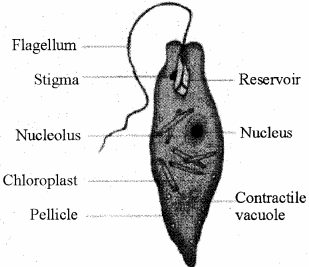
9. Phaeophyceae:
- Occurrence: Mostly marine.
- Pigments: Chi a, c carotenes, 3 carotenes and fucoxanthin (xanthophylls) are found but chi b is absent.
- Reserve food: Mannitol as well as Laminarin and fats.
- Example:lictocarpus, Sargassum.
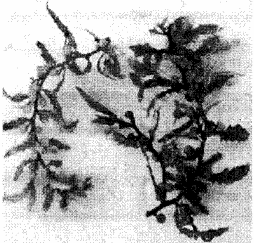
![]()
10. Rhodophyceae:
Commonly known as Red algae.
- Occurrence: Few forms are fresh water and others are marine.
- Pigments: Chlorophyll a and d, a and P carotenes. Chromatophores are red blue containing pigments like red rphycoerythrin and blue rphycocyanin.
- Reserve food: Floridean starch.
- Example: Polysiphonia, Batrachospermum,Porphyra, Banngai.
11. Myxophyceae :
Commonly known as Blue Green Algae (BGA) or Cyanophyceae.
- Occurrence: Found in sea and fresh water.
- Pigments: Chlorophyll a and c, carotenes, xanthophylls, c-phycocyanin and c-phycoerythrin are main pigments. The ratio of c-phycocyanin and c-phycoerythrin exhibits colour variation.
- Reserve food: Sugar and Glycogen.
Now individuals of this category are kept as Cyanobacteria in category of bacteria under the head of Kingdom- Monera (Prokaryotic) in modem classification due to its very rudimentary nucleus. No proper chromatophores, the photosynthetic pigments being diffused throughout the peripheral position. - Example: Oscillatoria, Nostoc, Anabaena.
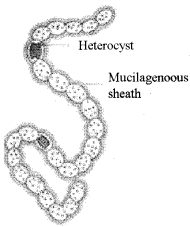
After Fritsch many other scientist also proposed classification such as G.M. Smith (1955), Round (1965), Chapman and Chapman (1973), Kumar and Singh (1971) and R.E. Lee (1987) but most accepted classification is ofF.E. Fritsch.
Characteristics of algae:
1. Habitat: Algae are predominantly aquatic through also found in other habitats. They are found in fresh water, salty and marine water, in ice and in moist conditions. Some algae are found in unusual places also.
2. Thallus organisation: Plant body is thalloid which is not differentiated into root, shoot and leaves. They are mostly represented by Gametophytic generation. Thallus may be unicellular or multicclluah.Chlamydomonas is motile unicellular agla while Chlorella is non motile unicellular aglae, Volvox is motile and colonial, Cladophora is filamentous etc.
3. They lack tissue differentiation and vascular tissues.
4. Cell wall of most of algae is made up of Cellulose and Pectin. In Brown algae (Phaeophyceae) cell wall is made up of Alginic acid and Fucinic acid along with cellulose. In Red algae (Rhodophyceae) cell wall has Polyesters suphates apart from cellulose.
5. All algae are Eukaryotic. Earlier Cynobacteria or blue green algae were included in aglae group but now shifted to Kingdom Monera alongwith bacteria because they are Prokaryotic in nature.
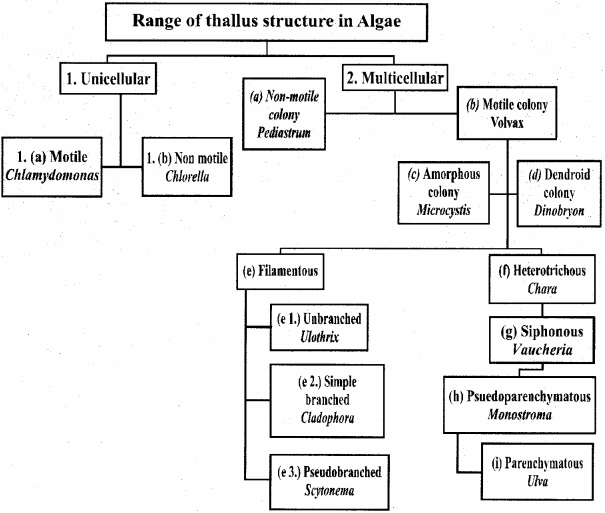
6. Algae are photoautotrophic in their mode of nutrition. Various type of photosynthetic pigments present in algae such as chlorophyll
(a, b, c, d, e), Carotenes (a, (3, y) and Xanthophylls. These pigments are present in Plastids. Plastid with chlorophyll is called chloroplasts which are of various shapes in algae.
7. Starch is usually main store food material in algae. Rarely fats and oils also may be store food material in some of the algae. Mostly algae have one or many pyrenoids which stores protein (in small amount) and starch. In Xanthophyceae, pyrenoids are absent.
8. Except Rhodophyceae (Red algae) all other algae have flagellar structures. Cynobacteria or blue green algae are also non flagellar in nature (now kept in Monera).
9. Reproduction in algae is by vegetative, asexual and sexual method.
10. Vegetative reproduction is very common and fast method of multiplying the numbers. It may be of various types such as fragmentation, fission, by hormogones, by adventitious branches, by tubers and by budding.
11. Asexual reproduction takes place majorly in algae in favourable conditions. During this reproduction motile and non motile spores are formed, e.g.; zoospores, aplanospores, autospores, hypnospores, tetraspores, akinintes, auxospores and by palmella stage.
12. Sexual reproduction takes place mainly in unfavourable conditions. It may takes place by three methods- isogamy, anisogamy and oogamy.
13. Sexual reproductive structures or gametangia are usually unicellular and non-jacketed. In case of multicellular algae each and every cell is fertile in nature. Male reproductive structure is named as antheridium and female reproductive structure is named as oogonium.
14. After fertilization zygote is formed but no formation of embryo takes place.
15. Haplontic type of alternation of generation is present in most of the algae. Main plant body represent gametophytic generation which is haploid, dominant and long lived while sporophytic generation is diploid, short lived and less dominant.
Question 2.
Write an essay on economic importance of aglae.
Answer:
- For a layman algae may not be so important economically but it is useful to man in various ways.
- Algae are very important in ecosystem. As producers they fix huge amount of solar energy into chemical eneigy and releases oxygen in environment.
- Algae are very important for seaside residents as wheat and rice is important for people’s livings on planes.
Economic importance of algae can be categorized into beneficial and harmful importance of algae.
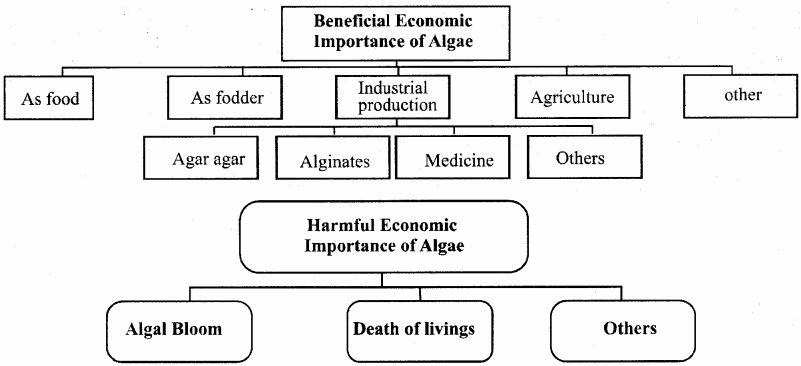
1. As food:
- Algae are used from ancient time as food. Various algae are rich in Carbohydrate, Proteins and inorganic nutrients.
- Most of the marine algae such as Porphyra tenera (Amanori- a Red algae) eaten with rice in Japan.
- Laminaria saccharina (Kombu- a Brown algae) is rich in carbohydrates.
- Alaria (Sarumen- a Brown algae) used in Japan as food.
- Sargassum, Alba, Laminaria, Rodomenia are rich in Vitamin B and C.In many countries marine algae are used to make delicious dishes.
- Fresh water aglae such as Chlorella and Spirulina (Green algae) are edible. It has about 50% protein and 20% of lipid and carbohydrates. Chlorella and Spirulina used to make cake and biscuits. These algae are used as tablets for malnutrition.
- Chlorella and Spirulina are called space traveller’s food.Chlorella contains all the amino acids essential for human nutrition.
2. As fodder:
Many marine algae especially brown algae (Phaeophyceae) such as Sargassum, Fucus, Laminaria, Macrocystis served as fodder to cattles. These algae used to make food for pigs and poultry. Many algae used as food by fishes, e.g., Microspora, Oodogonium.
3. Industrial products:
various products are produced by algae which are used for many purposes. As Medicine :
- Brwon algae particularly Laminaria or Kelps are rich source of soda, potash and iodine.
- Laminaria, Fucus and Ecklonia(Brown algae) are used in treatment of Goiter due to high amount of iodine.
- Gelidium(Rcd algae)used to make medicine for gastric related diseases.
- Corallina (Red algae) are used for the treatment of kidney, lung diseases.
- Polysiphonia (Red algae) has antibacterial properties.Carrageenin (Red algae) acts as blood coagulant.
- Mosquito does not breed in those water bodies where Chara and Nitella are grown.
- Chlorella (Green algae) yields an antibiotic chlorellin which is used against E.coli, Shigella dysenteria and Staphylococous aureus.
- Agar-Agar: Geledium, Condrus, Gracilaria and Gigartina (Red algae) produce powdery substance agaragar which form gel with water. It is nitrogen free. Agar- agar is used for microbial culture, in bakery industry, cosmetics, making of ice-cream, leather industry, textile industry and canned meat industry etc.
- Alginatesr : lt is phycocolloid extract commercially from Sargassum (brown algae) giant brown algae or kelps (Laminaria, Fucus, Ascophyllum, Macrocystis, Ecklonia etc.). Alginates are used as thickner (in preparation of soap, sauce, cream, printing ink), emulsifier (in ice cream, polish, emulsion paints) and gelling agent (in confectionery and dental impression powder). It is also used in sizing textiles, making of flame proof plastics, security glasses and for binding panel boards.
4. In Agriculture:
Higher plants cannot fix atmospheric nitrogen into nitrates which required for normal grow Oscillatoria, Nos toe, Anabaena, Olocera and Cytonia (Blue green algae) can fix atmospheric nitrogen into nitrates. Nitrates increases fertility of soil.Algae like Nostoc, Anabaena make soil suitable for agriculture by reducing high pH of soil.
- Algae like Fucus, sargamssum used as manure in soil.
- others: some alge like chlorella synechoccus are best for space research programme Algae like Fucus, Sorgassum used as manure in soil.
- Others: Some algae like Chiorella, Synechococcus arebest for space research programme.
- Chlorella and Chlamrdomonas are used in sewagedisposal ponds. They remove CO2 and restore O2 by the process of photosynthesis and make the sewage water habitable for many fishes and aerobic bacteria.
- Rhodomella and Popsiphonia are used to obtain Bromine of commercial importance. Carrageeninis extracted from Chondrus. It is also usedas an emulsifier in chocolates. icecreams. tooth paste,paints etc.
- Funori is obtained from Gloiopeltis. It is a kind of gluethat is used as adhesive.
- Algin: it is cell wall derivative of some brown algae likeAlaria, Ascophyllum, Fucus. Et is widely used inpreventing formation of crystals in ice-creams, used tostop bleeding and in preparation of soups, creams andsauces etc.
- Blue green algae like Aulosira and Anabaena and green algae like Chara and Nitella eliminate mosquito larvae from ponds.
Harmful Economic Importance of Algae:
- Water Blooms or Alga Bloom: Presence of large amounts of nutrients in waters also causes excessive growth of planktonic (free-floating) algae such as Microcystis, Oscillatoria, called an algal bloom which imparts a distinct colour to the water bodies. Algal blooms cause deterioration of the water quality and fish mortality due to deficiency of 02 in water. Some bloom-forming algae are extremely toxic to human beings and animals
- Death of Fishes: Aphanizomenon and Microcystis are toxic for Gambusia and Crepis fish and die when they feed upon them.
- Others: The green alga Cephaleuros virescens cuases red rust on the leaves of tea and C. coffeae causes red ust on the leaves of coffee. Gonyaulax and Gymnodinium are toxic for human. Gonyaulx releases a toxin tetradon toxin which enters in humans via fishes. It causes numbness and paralysis
Question 3.
Explain main characteristics of bryophyte and describe its classification.
Answer:
characteristics of Bryophyte :
Habitat:
Bryophytes usually grow in moist and shady places. The plants grow densely together and form green carpetsor mats on damp soil, rock. walls and barks of trees and on decaying logs in forests, especially during the rainy season. some one bryophytes are well adapted to grow in most unusual conditions.For example, the so called ‘copper mosses’ grow only in the soilwhich is rich in copper deposits and therefore.the are used as indicator plantsfor copper.
The bryophytes are fundamentally terrestrial plants butrequire presence of water to complete their life cycle.
Some bryophytes grow in diverse habitats such as
- aquatict (eg.Riccia fluitans. R. ahuenesis. Ricsiocarpusnatans. riella Sphagnum).
- epiphytes, (eg.Frulenia.Dendroceros. Radula prorensa and many(Beiges).
- saprophytes(ég.Buxbaunia Sphylia,Cryptothallus mirabilis) and
- in dry habitats such as dry heath s (e.g.Polytrichum juniperinuni). deserts(eg.Tortula dese’rtorum) and dry rocks (eg. Porella plaryphylla,).
The water is needed for:
- dchisccncc of anthcridia,
- liberation of antherozoids,
- transfèr of antherozoids from antheridia to archegonia.
- opening of archegonialneck, and
- the movement of antherozoids into thearchegonial neck.
2. Nutrition:
They are green due to chlorophyll pigment andautotrophic but ( ryprothallus mirab ills is saprophyticin nature,
3. Nature:
- The life cycle of bryophytes consists of two distinctphases
(i) the gamctophtic phase and
(ii) the sporophvtic phase. - The haploid gemetophyte is dominant, long-lived,green and Independent where as the diploid sporophyteis short-lived and dependent upon the gametophyte.
- The two phases come one after the other in alternating manner and both are morphologically distinct.
- The plants are small, range from few millimetres (eg.Zoopsis) to 30-40 centimetres.
- The tallest species may reach up to 70 cm in length (eg.Dawsonia).
4. Morphology:
- The gametophvtes are thalloid i.e, body is not diffetentiated into true roots, true stem and true leaves or leafy shoot having stem-like central axis and leaf-like appendages.
- The roots are completely absent and they are replacedby unicellular or multicellular thread like rhizoids.
The bryophytic thalli also absorb moisture directly from the ground or the atmosphere and, therefore. they grow well in moist places. - The vascular tissues (‘i.e.xylem and phloem) arecompletely absent.
- The water and food materials arc transported from cellto cell.
5. Reproduction:
Vegetative and sexual reproduction is exists inbryophytes. Asexual reproduction is absent in them. The vegetative reproduction takes place byfragmentation. tubers, adventitious branches. gemmac,formation of innovations and formation of secondary protonelna. Sexual reproduction is oogamousi I.e. the male gametesare small and flagellated sperms or antherozoids anfemale gametes arc large and non-motile eggs. The sex organs are multi cellular and jacketed withsterile jacket. The male reproductive organs areantheridia (singular: Antheridium)and femalereproductive organs are archeridia (singular: Archigonium). The anthcridium is differentiated into stalk and body. It produces flagellated male gametes, called sperms or antherozoids (n).
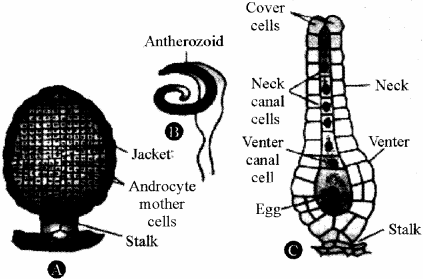
The archegoniumis flask shaped with clearly defined venter and neck. The neck encloses variable numbers of neck canal cells (NCC.) whereas venter, encloses venter canal cell (V.C.C.) and a large naked egg (n). The male gametes are liberated from antheridia, swim in a film of water (rain water or dew) and attracted towards the archegonium by chemotactic movement. They enter into the archegonia and fertilize the egg to form zygote (2n). Fertilization always takes place in presence of water. The diploid fertilized egg (zygote) is the first cell of sporophytic generation. It divides and develops into a sporophytic plant body,called sporogonium.
The sporogonium, in most of the cases, is differentiated into foot, seta and capsule. The sporogonium is completely dependret on the gametophyte for water and mineral supply and, in most of the cases. partly or wholly for organic nutrition. The sporogonium remains attached to the gametophytic plant both’ throughout its life.
The sporogonium is concerned with the production of asexually formed haploid spores (or meiospores). The spores are produced inside the capsule of sporogomaby meiosis in the spore mother cells. The spores are the first cells of gametophytic generation. Spores germinate to produce the gametophytic plant body either directly or through a juvenile filamentous stage.called protonema. All spores are same so brophytes aThus, alternation of generation is heterologous or heteromorphic.
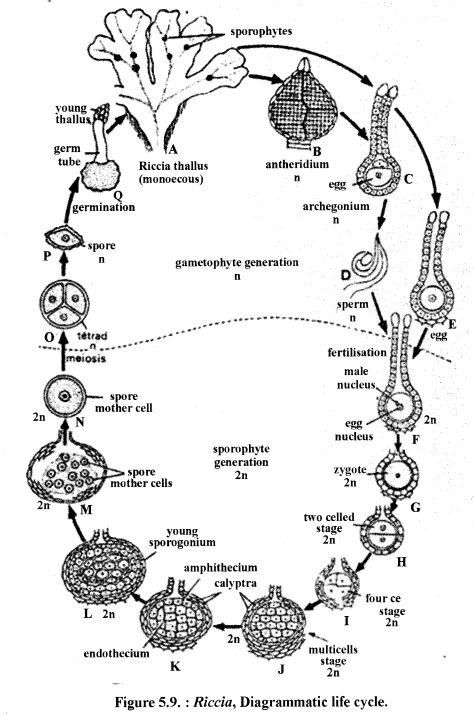
classification of Bryophytes:
Eichler (1883), Cavers (1911), Bower (1935) and Evans(1938) played important role in classification of bryophytes but Rothmaler (1951) and Proskauer (1957)gave modem classification of bryophytes.
Bryophytes are generally classified into three main classes:
- Hepaticopsida – Commonh called liver worts.
- Anthocerotopsida – Commonly called horn worts.
- Bryopsida – Commonly called mosses.
1. Class Hepaticopsida:
- Commonly known as Liverworts.The gametophytic plant body of liverworts is usually dorsiventral. leaf-like and gives the appearance of liver.
- The common examples of liverworts are Riccia,Marchantia. Pellia, etc.

The vegetative plant both of Marchantia is a dorsiventral lobed thailus. It is dichotomously branched. The upper surface of thallus is smooth. On lower surface large number of unicellular and unbranched rhizoids arepresent which penetrate into the soil. Asexual reproduction in Marchantia occurs by the formation of gernmae. The gemmae are multi cellular.green and biconvex-lens shaped bodies produced in gemma cups. They detach from gemma cups and germinate to produce new plants. Sexual reproduction occurs by the formation of sex organs born on special branches. The male ‘antheridia’ are borne on antheridiophores.
They produce flagellated antherozoids or sperms (n).The female reproductive organs are ‘archegonia’.They are borne on special stalked branches called archegoniopho rest. Each archaegonium is differentiated into neck and venter and egg is enclosed inside the venter . After fertilization, the egg becomes zygote (2N) which grows to produce sporophyte. The sporophyte of bryophytes is called sporogonium. The sporogonium cf Marehantia is very small. It is differentiated into a bulbous foot, short seta and an oavl capsule Inside the capsule, the diploid spore mother cells divide by’ meiosis and produce haploid spores which are dispersed by wind. In some members along with spores elaters we also formed Eg. Riccia. Marchanlia, Plagiochinia.
2. Class Anthocerotopsida:
- Commonly called Hornworts.
- Gametophytes of hornworts arc also flat and dorsiventral. like Liverworts it is not differentiated, butthe sporophytes are long and look like horns.
- Every cell of thallus having one large chioroplast andone pyrenoid. It is an algal characters.
- Rhizoids are unicellular, smooth and branched.
- Antherozoids are endogenous mean they are embeddedin dorsal surface of thallus. Sporophyte is linear in structure.
- The common example of hornworts arc Anthoceros and Not othvies.RBSE Solutions for Class 11 Biology Chapter 5 Plant Kingdom.

3. Class Bryopsida:
Commonly called Mosses. Mosses are widel distributed and occur from the Arcticthrough the tropics to parts of Antarctica. They grow in close tufts in moist and shady places.‘ Some mosses grow in deserts bogs and steams. Usually they form green carpets or mats on moist and shady walls.damp soil and on tree trunks. mostly during the rainy season. The common examples of mosses are Funaria and Polywichum. .Svhagnum.‘ The gametophviic plant body is leafy axis and radially smmetrical.
The axis may be unbranched or branched. The leaf-like lobes are simple. sessile and usually with adistinct nonvascular mid rib. They are spirally arranged on the axis. The rhizoids are multicellular, branched and have oblique septa. Sex organs (i.e., antheridia and archegonia) are usually borne in groups at the a pices of reproductive branches.


The sporophte is usually differentiated into foot, seta and capsule. The capsule has several layered all it hstomata on its epidermis. The capsule usually has aperistome which helps in the spore dispersal. The haploid spores germinate to form a juvenile protonemal stage represented by a filamentous or discoid structure, which gives rise to erect gametophores.
Question 4.
Explain main characteristics of pteridophyta.
Answer:
Characteristics of Pteridophytes:
- It originated in Silurian period of Palaeozoic Era
- It is the most primitive group. that flourished in Devonian and Carboniferous periods of Palaeozoic Era.
- They are more than forty four million old.
- The Pteridophytes include horsetails and ferns.
1. Habitat:
Evolutionary, they are the first terrestrial plants to possess vascular tissues – xylem and phloem. The pteridophytes are found in cool, damp, shady places though some may flourish well in sandy -soil conditions.
Some pteridophytes are found in other habitat also such as Azola, Salvinia and Marsilea found in aquatic condition. Isocitis found in marshy condition while Actinopteris found in desertic condition.
2. Habit:
In pteridophytes, the main plant body is a sporophyte which is differentiated into true root, stem and leaves but exceptionally in Psilotum roots and leaves are totally absent. Mostly perennial small herbs, shrub or trees, e.g., Pteris (Herb), osmunda regali, Tectoria (Shrub) and also phila(tree) but Azolla. Salvinia are annual and small herbs.
3. Primary roots are short lived which are substituted by adventitious roots.
4. The leaves in pteridophyta are scaly and small (microphylls) as in Equisetum, Lycopodium and Selciginellaov large (macrophylls) as in all ferns such as Adiantum. Pteris, Marsilea etc.
5. All body organs possess well -differentiated vascular tissues which made up of xylem and phloem. Vessels are absent in xylem and companion cells and sieve tubes are absent in phloem. Xylem is mainly made up of tracheids and phloem is mainly made up of sieve cellsbut exceptionally in some Pteridophytes vessels are present such as Equisetum, Selaginella and Marsilea.
6. Cambium is absent in Pteridophyta so no secondary growth in Pteridophyta (Exception: In Isocitis and Botrychium cambium present).
7. Pteridophtes also named as Vascular Cryptogamous because they are non floral plants with xylem and phloem. They are flowerless, seedless, spore producing vascular plants which have successfully invaded the land.
8. Reproduction:
Vegetative, asexual and sexual reproduction present in Pteridophyta. Vegetative and asexual reproduction is performed by sporophyte and sexual reproduction is performed by gametophyte.

9. Vegetative reproduction takes place by fragmentation and decay, Bulbils or Gemmae and by adventitious buds. Vegetative reproduction is not so common in Pteridophytes.
10. Asexual reproduction takes place by spores which are formed in sporangia on sporophyte. The sporangia are borne on leaf-like appendages called sporophylls in sporophyte stage. In some cases sporophylls may form distinct compact structures called strobili or cones (Selaginella, Equisetum). The sporangia produce spores (n) by meiosis in spore mother cells (2n). In majority of the pteridophytes all the spores are of similar kinds; such plants are called homosporous, eg.Equisetum, Pteris and other ferns but in 8-9 plants of genera like Selaginella and Salvinia which produce two kinds of spores, macro (large) and micro (small) spores, are known as heterosporous . Microspores develop in microsporangium while macrospore develops in megasporangium.
11. The spores (n) germinate to give rise to inconspicuous, small but multicellular, free-living, mostly photosynthetic thalloid gametophytes (n) called prothallus. in homosporous pteridophytes. Prothalus of main homosporous pteridophytes is heart shaped.In heterosporous pteridophyte. the megaspores germinate and give rise to female gametophytes and microspores germinate and giverise to male gametophytes.
The female gametophytes in these plants are retained on the parent sporophytes for variable periods. When Antheridia and Archegonia formed on same thallus then this condition is called monoecious but in some pteridophytes both the structure are formed on different thallus then it is called Dioecious. Sex organs are multicelluar which are enclosed with mutlicellular sterile jacket. In Antheridium flagellated male gamete Antherozoids are formed and in Archegonium non motile female gamete egg cell is formed.
Movement of antherozoids towards archegonium is chemotactic. Water is required for fertilization. The development of the zygote into young embryo takes place within the female gametophytes. This event is a precursor to the seed habit considered an important step in evolution. These gametophytes require cool, damp, shady places to grow because of this specific restricted requirement and the need of water for fertilisation, the spread of living pteridophytes is limited and restricted to narrow geographical regions. The gametophytes bear male and female sex organs called antheridia and archegonia, respectively.
Water is required for transfer of antherozoids(the male gametes) released from the antheridia, to the mouth of archegonium. Fusion of male gamete with the egg present in the archegonium result in the formation of zygote. Zygote there after produces a multicellular well-differentiated sporophyte which is the dominant phase of the pteridophytes.
In Pteridophytes embryo are of two types: (1 )Exoscopic (2) Endoscopic
- Endoscopic: In genera, like Lycopodium. Selaginella, Isoetes, some eusporangiate ferns and a majority of archegoniates, the apex of the embryo is directed inward,i.e.towards the tissue of the gametophytes or away from the archegonial neck. Such embryos are called endoscopic.
- Exoscopic: In genera, like Psilotum, Tmesipteris, Stromatopteris, Ophioglossum, etc, the apex of the embryo is directed outwards, i.e. away from the gametophyte or towards the archegonial neck. Such embryos are called exoscopic .In some pteridophytes, however, both the above mentioned patterns can be seen, e.g. Botrychium. In many leptosporangiate ferns, the embryos appear to be endoscopic but no definite pattern can be established.
Question 5.
Explain main characteristics of Gymnosperm.
Answer:
- Gymnosperms are mostly perennials, xerophytic, evergreen, arboreal and woody.
- They grow as woody trees, bushy shrubs or rarely as climbers (e.g., Gnetales).
- None of them are herbs or annuals.
- The main plant body is diploid sporophyte which is well differentiated into root, stem and leaves.
- They possess well developed tap root system. In some cases the roots are symbiotically associated with aglae (eg. coralloid roots of Cycas) or with fungus (eg.Ectotrophic mycorrhizal roots oil Pinus) The coralloid roots contain symbiotic cyanobacteria. (blue-green algae such as Nostoc and Anabaena), which fix nitrogen and, in association with root tissues, produce such beneficial amino acids as asparagine and citrulline. The symbiotic association of the my celium of a fungus with the roots of plants. The majority of vascular plants have mycorrhizae. The fungus assists in the absorption of minerals and water from the soil and defends the roots from other fungi and nematodes, while the plant provides carbohydrates to the fungus.
- The stem is erect, aerial, solid, and woody and branched (unbranched in Cycas).
- Leaves are dimorphic. They possess two types of leaves brown: coloured, membranous, minute, deciduousscaly leaves and green coloured, simple, needle like or pinnately compound foliage leaves.
- The leaves may be simple or compound. In Cycas the pinnate leaves persist for a few years. The leaves in gymnosperms are well-adapted to withstand extremes of temperature, humidity and wind. In conifers, the needle-like leaves reduce the surface area. Their thick cuticle and sunken stomata also help to reduce water loss.
- Presence of leaf scar on stem after shading off leaves is peculiar characteristics of gymnosperms.
- World’s tallest tree – Sequoia sempervirens(the giant red wood) is about 125 metres in height and 30 metres in girth. This plant is about 4000 years old and found in red wood park of California.
- Smallest gymnosperm is Zamiapygmia is only up to 25 cm. in height.
Question 6.
Explain main characteristics of Angiosperm.
Answer:
1. Distribution: They grow in almost all types of habitats (worldwide). They grow in Arctic, Antarctic area .as well as in Mediterranean area.
2. Habitat: angiosperms grow in almost every kind of habitats. Some grow at an altitude of 6,000 metres in the Himalayas. Some are found in frozen condition of Antarctica. They are found on plains, hilly areas, seas, lakes and in desert conditions. Opuntia is a xerophyte, Hydrilla, Vallisineria are submerged fresh water hydrophytes, Zostera marina found in shallow seas and some are found as mangrove vegetation in Estuary, eg. Rhizophora, Avicinia. In rain forests, some plants grow on the branches of other plants but do not obtain water or food from them, they are called epiphytes, eg. Irenda. Most of the plants are terrestrial and herbs, shrubs and trees, eg. Neem, Peepal, Mango, Wheat, and Pea etc.
3. Habit: plant of this category show diversity in their habits. Wolfia is smallest angiosperms (size: 2.00 mm), tallest angiosperm is Eucalyptus (300-400 feets). Most of the plants are grasses or herbs, shrubs, trees and climbers. Herb- Tribulus, Grass- Cyanadon, Shrub-Calotropis, Tree-Acacia (Babool), Climber- Bouganivillea etc.
4. Main plant body is sporophyte. They have well developed root system, stem system. Stem system is made up of leaves and stem.
5. Nutrition: mostly photosynthetic. Some show hetrotrophic mode of nutrition, e.g., Cuscuta and Orobranche are parasitic, Indian Pipe plant (Monotropa) saprophytic, Nehenthes and Venus fly trap (Dionaea) are insectivore in nature.
6. Anatomy: In angiosperm well developed vascular system exists. Xylem and Phloem both are made of four elements each. Xylem is made up of Tracheids, vessels, xylem parenchyma and xylem fibres. Phloem is made up of sieve tubes, companion cells, phloem parenchyma and phloem fibres. Cambium is present in dicotyledons for secondary growth.
7. Characters related with reproduction: angiosperms are flowering plants. Flower is a modified shoot with fertile leaves for sexual reproduction. Stamen is microsporophyll while pistil is macrosrporophy.
8. Male and female gametophytes are highly reduced.
9. Pollen grains are received by stigma of pistil during pollination to reach up to ovule.
10. Fertilization is siphonogamous type in which pollen tube is formed to transfer non motile male gametes up to egg cell.
11. Endosperm is triploid it forms after fertilization to provide nutrition to developing embryo.
12. In angiosperm double fertilization and triple fusion, present.
13. Seeds are protected inside fruit.
14. Seeds have one or two cotyledons.
Question 7.
Write economic importance of gymnosperms.
Answer:
- Vascular tissue: Plant possess well developed vascular tissues i.e., xylem and phloem. The vessels are absent in the xylem (except Gnetales) and companion cells and sieve tube are absent in phloem.Gymnosperms have albuminous cells and sieve cells. Vascular bundles are conjoint, collateral and open.
- Secondary growth occurs and annual rings are distinct in most of the gymnosperms.
- The wood formed after secondary growth is called soft wood because in it vessels are absent.
- Plants show xerophytic adaptation such as thick cuticle and sunken stomata on leaf.
Question 8.
Differentiate Angiosperm and Gymnosperms.
Answer:
Gymnosperms:
- The gymnosperms are comparatively more ancient than the angiosperms in evolutionary terms.
- This group is formed by Greek philosopher and father of botany Theophrastus (300 B.C.) for plants with naked seeds.
- Naked seed plant does not mean that seeds of these plants do not have seed coat because in these plants seeds have seed coat.
- Actually Gymnosperms mean fruitless seeded plants or Phanerogams without fruits because in them fruit is absent.
- Gymnosperms are the most ancient seeded plants on earth.
- They originated during the late Palaeozoic era (about 280 million years ago) and flourish during the Mesozoic era (about 110-270 million years ago in the age of the dinosaurs.)
- Most of the gymnosperms have now become extinct and the group is presently represented by only 700-725 species in world while in Rajasthan only one species of it exists i.e.Ephedra foliata in deserts.
- Many plants of this category found as fossils like Williamsonia plant.Most of the surviving plants of gymnosperms are conifers or cone bearing plants.
- They are mostly distributed in the cooler northern region of Europe, Asia and North America as well as in in the upper timber line zone of mountain ranges including Himalayas.
- The living Gymnosperms are distributed in the cold climates where snow, rather than rain, is the source of
- water except Cycas (a small group of gymnosperms with palm like leaves in warmer areas).
- Cycas is the plant from this category which produces largest sperms in plant kingdom.
External morphological characters:
1. Gymnosperms are mostly perennials, xerophytic, evergreen, arboreal and woody.
2. They grow as woody trees, bushy shrubs or rarely as climbers (eg.Gnetales).
3. None of them are herbs or annuals.
4. The main plant body is diploid sporophyte which is well differentiated into root, stem and leaves.
5. They possess well developed tap root system. In some cases the roots are symbiotically associated with aglae (eg.coralloid roots of Cycas) or with fungus (eg. Ectotrophic mycorrhizal roots oil Pinus) The coralloid roots contain symbiotic cyanobacteria (blue-green algae such as Nostoc and Anabaena), which fix nitrogen and, in association with root tissues, produce such beneficial amino acids as as paragine and citrulline. The symbiotic association of the mycelium of a fungus with the roots of plants. The majority of vascular plants have mycorrhizae. The fungus assists in the absorption of minerals and water from the soil and defends the roots from other fungi and nematodes, while the plant provides carbohydrates to the fungus.
6. The stem is erect, aerial, solid, and woody and branched (unbranched in Cycas).
7. Leaves are dimorphic. They possess two types of leaves brown: coloured, membranous, minute, deciduousscaly leaves and green coloured, simple, needle like or pinnately compound foliage leaves.
8. The leaves may be simple or compound. In Cycas the pinnate leaves persist for a fewyears. The leaves in gymnosperms are well-adapted to withstand extremes of temperature, humidity and wind. In conifers, the needle-like leaves reduce the surface area. Their thick cuticle and sunken stomata also help to reduce water loss.
9. Presence of leaf scar on stem after shading off leaves is peculiar characteristics of gymnosperms.
10. World’s tallest tree – Sequoia sempervirens(thc giant red wood) is about 125 metres in height and 30 metres in girth. This plant is about 4000 years old and found in red wood park of California.
11. Smallest gymnosperm is Zamiapygmia is only up to 25 cm. in height.
Anatomical (internal) characters:
- Vascular tissue: Plant possess well developed vascular tissues i.e., xylem and phloem. The vessels are absent in the xylem (except Gnetales) and companion cells and sieve tube are absent in phloem.Gymnosperms have albuminous cells and sieve cells. Vascular bundles are conjoint, collateral and open.
- Secondary growth occurs and annual rings are distinct in most of the gymnosperms.
- The wood formed after secondary growth is called soft wood because in it vessels are absent.
- Plants show xerophytic adaptation such as thick cuticle and sunken stomata on leaf.
Reproduction:
Gymnosperms are heterosporous, ie. produce two different kinds of spores- the male microspores and the female megaspores.

Repraduction
- The spores are borne inside the sporangia.
- The two types of sporangia are borne on special leaf like structures, called sporophylls.
- The microsporangia (pollen sacs) are borne on microsporophylls (stamens) and the megasporangia (ovules) are borne on megasporophylls (carpels).
- The sporophylls are usually spirally arranged in the form of compact structures called lax or cones or strobili (In Cyeas female cone is not formed).
- The cones are unisexual means they are monosporangiate type, ie. the male cones or male strobili are microsporangiate (pollen cones) and present on male plant body. the female cones present one female body or female strobili are megasporangiate (seed cones) present on female body; exceptionally in Ephedra,some species of Gnetum and Pinus excelsa have both the cones on same plant body.
- The male cones are short lived whereas the female cones are long lived comparatively and remain attached on the plants for many years till the maturity or ripening of the seeds.
- The male or female cones or strobili may be borne on the same tree (Pinus).However, in Cycas male cones and megasporophylls are borne on different trees.
- Unlike bryophytes and pteridophytes, in gymnosperms the male and the female gametophytes do not have an independent free-living existence (means they are dependent upon the sprophyte).
- The microsporangium (pollen sac) produces numerous light pollen grains.The microspores develop into a male gametophytic generation which is highly reduced and is confined to only a limited number of cells ie.one or two prothallial cells, a tube nucleus, a stalk nucleus and two male gametes. This reduced gametophyte is called a pollen grain.The development of pollen grains takes place within the microsporangia (except Cycades and Gingko male gametes are non-motile and aciliary which are carried out upto archegonia by pollen tube).
- Each megasporangium is naked structure, i.e., it is not enclosed within the ovary wall. As the megasporangium is’surrounded by integuments it also known as ovule.
- The ovules are orthotropous. It is surrounded by integuments. It encloses the nucellus and a multicellular female gametophyte formed from the haploid megaspore. The female gametophyte contains archegonia.
- Archegonia do not have neck canal cells (N.C.C.) and venter canal cells (V.C.C.).
- Pollination is anemophilous (wind pollination). Pollen grains are directly deposited at micropyle of the ovule.
Upon landing on the female cone, the tube cell of the pollen forms the pollen tube, through which the generative cell migrates towards the female gametophyte through the micropyle. - It takes approximately one year for the pollen tube to grow and migrate towards the female gametophyte.
- The male gametophyte containing the generative cell produces two male gametes which are generally carried out by the pollen tube up to egg cell, one of which fuses with the egg, while the other degenerates.
After fertilization of the egg cell forms diploid zygote which divides by mitosis to form the embryo. - Fertilization in gymnosperms is siphonogamy type in which male gametes are carried to the archegonia through pollen tube.Fertilization takes place in the absence of external water.
- Development of endosperm completes before fertilization. Endosperm in gymnosperm is alwayshaploid.
In gymnosperms double fertilization and triple fusion is absent. - Number of cotyledons in seed are two (Cycas) or more (Pinus).
- Polyembryony (formation of more than one embryo in one seed is called polyembryony) is common characteristics of gymnosperms.
- Fruit absent in gymnosperm because no ovary is formed in gymnosperms.
Classification of Gymnosperms:
Many scientists gave classification of gymnosperms but we will study here Chamberlain’s classification. Chamberlain (1934) classified extinct and living genus of gymnosperms into two divisions and 7 Orders.
Division- Cvcadophvta:
- Order- Cycadofilicales- all individuals extinct of this Order, eg. Lyginopteris, Medulos.
- Order-Cycadeoidales- all individuals extinct of this Order, e.g., Williamsonia, Cycadeo idea.
- Order-Cycadales- some are extinct and some are living individuals of this Order, e.g., Cycas, Gemina, Nilsonia.
Division- Coniferophvta
- Order-Cordaitales- all individuals extinct of this Order, eg. Chordaities, Mesoxylon.
- Order- Ginkgoales- most of the individuals is extinct. Only one is living member of this group is Ginkgo biloba.
- Order- Coniferales-some individuals are extinct and some are living of this Order, e.g., Pinus, Cedrus, Thuja, and Araucaria.
- Order-Gnetales- only three living genus from this Order, e.g., Ephedra, Gnetum, Welwitschia.

main characterstics of Class Gymnosperms:
(a) Class- Cycadopsida:
- They are Palm like in shape, stem is cylindrical, unbranched and with scars of leaf.
- Leaves are usually pinnate, compound and spirally arranged.
- Vascular bundles of stem are conjoint, collateral, endarch and open types which are arranged in a ring.
- Secondary growth forms monxvlic wood.
- All are Dioecious in nature and male or female cones develop at the apex of tree as per sex. In Cycas no formation of female cones.
(B) Class- Coniferopsida:
- It is largest class of Gymnosperms. Individuals are evergreen with branched and wood stem.
- Tap root system is present in which corolloid fungus is found as symbiotic condition.
Two type of branch exists in it: (i) Dwarf shoot (ii) Long shoots. - Two types of leaves exist in it: (i) brown scaly leavesh(ii) green fleshy leaves.
Secondary growth results in formation of Pycnoxylic wood. - Usually Resin ducts are present in it.
- Usually plants are dioecious but some are monoecius.
- All individuals produce male or female cones are per the sex.
- Male gametes are nonmotile, endosperm and many cotyledons are present in seed.
(C) Class- Gnetopsida:
- Plants are shrub, trees in nature. Welwitschi astern is tuberous and leaves are long.
- Leaves are arranged spirally, whorled or opposite.
- Vessels are present in secondary wood.
- Cones are unisexual and plants are dioecious.
- Ovule is covered by two integuments. Inner integument is long and form micropylar tube.
- The turpentine is chiefly used as a solvent in pharmaceutical preparations, perfume industry in manufacture of synthetic pine oil, disinfectants
Economical importance of Gymnosperms:
1. For Timber:
- Wood of many trees used for various purpose, eg. species of Pinus, Cedrus, Abies used for making furniture, windows, railway slipper, packing cartoons etc.
- Wood of Juniperus vergianauscd to make pencil, scale and pens.
- Wood of Texodium, Podocarpous is used for making plywood.
2. For Resin and Oil:
- Pinus roxburghiiwd P. belchianaxxsed commercially toproduce resin. On distillation, the resin yields an essential oil, commonly known as turpentine, and non-volatilerosin.
- The proportion of rosin and turpentine oil in chirpine is 75% and 22% respectively with 3% losses, etc the turpentine It is one of the most important basic raw materials for the synthesis of terpene chemicals which are used in a wide variety of industries such as adhesives, paper and rubber, etc.
- Canada balsam – It is turpentine obtained from Pinus, Layrix and Abies balsamea and used as a mounting medium in biological preparations. These plants produce varnish, tenin also.
3. Paper Industry:
- Wood of Gymnosperms is soft so used to make paper pulp, eg.Pinus merkusii and Picea.
- Papers like new sprints, writing and printing papers are being prepared from the wood pulp of Pinus, Picea, Abeis, Gnetum etc.
4. As Food:
- Pinus gerardiana is plant which contains very delicious seeds; roasted seeds are locally called Chilgoza/ Shangthi.Chilgoza is added in dry fruits. ‘Sago’ (Sabutdana in hindi) is obtained from starch of Cycas stem after boiling it.Roasted seeds of
- Cycas and Gnetum are edible. In Ladakh bark of Texasis used for tea.
- ‘Sago’ starch obtained from pith and cortex of stem of C. revolute, C. rumphi etc. .
- ‘Seed starch’ obtained from seeds of Cycas rumphii, Dioonedule etc. It is prepared into flour and cooked before eating.
- ‘Kaffir bread’ prepared from the stem pith of Encephalartos.
Young leaves of Cycas cooked as vegetables.
5. Ornamental value:
A number of gymnosperm plants are grown as ornamental plants, e.g., Cycas revoluta, C. circinalis, Gemia, Cupresus, Araucaria, Thuja etc.
6. Medicinal value:
- Ephedrine (alkaloid) extracted from various species of Ephedra used in treating asthma, cough, cold, bronchitis and Hay fever etc.
- Wood of Cidrus used in treatment of Diruesis and it is Carminative.
- Thuja is used for treatment of Gout, Fever, and cough.
- Texol is very effective alkaloid from Texas used forcancer treatment.
- Tincture of Ephedra is a cardiac stimulant.
- The juice extracted from young leaves of Cycas revoluta is used for curing blood vomiting and flatulence.
- Juice of leaves from Cycas cirein us used for treatment of stomachache and skin diseases.
7. Industrial Use:
- Gum-Cycas gum used as adhesive, antidote for snake bites and using malignant ulcers.
- Tannins – Tannins extracted from bark of Araucaria, Pinus, Sequoia etc. used in leather industry.
- Amber (fossil resin) – obtained from Pinus succinifera. Wood of Pinus is used for doors, poles, beams, railway wagon flooring etc.
- The leaves of cycads are used for preparing baskets, mats, hats, brooms etc.
- The fibres obtained from the leaves of Cycas and Macrozamia are used for stuffing pillows and making mattresses.
8. Source of oils:
- Springy wood of Taxus baccata is used to make bows.
- In hilly area wood of Gymnosperm plants is used for fuel.
- Wood of Tsuga plant is used to make roof top of huts.
- Woods of many plants are used to make boat paddle, plough or plow, bullock carton etc.
- Wood of Picea and Abeis used to make water trough.
- Oils extracted from seeds of C. revoluta, Macrozamia refdlei, Pinus cembra and Cephalotaxus drupacea are used as edible oils.
- Red cedar wood oil extracted from the heart wood of Juniperus virginiana is used for cleaning microscopic preparations and for oil immersion lenses.
- Oils obtained from Cedrus deodara, Ciyptomeria japonica and Cupressus serm-perivirens are used in preparations of perfumes.
Angiosperms:
They are flowering plants in which ovary is present which get modified into fruit after fertilization. Seeds in plants of this category are enclosed in pericarp (fruit wall). The term “angiosperm” means ‘enclosed seed’ because the ovules or potential seeds are enclosed within a hollow ovary. Angiosperms are considered most highly evolved and advanced plants.
They probably appeared on earth about 145 million years ago during the age of Jurassic Cretaceous periods of Mesozoic era, long before the evolution of man. Angiosperms far exceed all other major groups of living plants in number and diversity of form and structure. They are 260000 species in numbers worldwide, 17672 species in India and in Rajasthan they are 2200 species in numbers.
chacterstics of Angiosperms:
1. Distribution – They grow in almost all types of habitats (worldwide). They grow in Arctic, Antarctic area .as well as in Mediterranean area.
2. Habitat – angiosperms grow in almost every kind of habitats. Some grow at an altitude of 6,000 metres in the Himalayas. Some are found in frozen condition of Antarctica. They are found on plains, hilly areas, seas, lakes and in desert conditions. Opuntia is a xerophyte, Hydrilla, Vallisineria are submerged fresh water hydrophytes, Zostera marina found in shallow seasand some are found as mangrove vegetation in Estuary, e.g., Rhizophora, Avicinia.
In rain forests, some plants grow on the branches of other plants but do not obtain water or food from them, they are called epiphytes, e.g,. Irenda. Most of the plants are terrestrial and herbs, shrubs and trees, e.g., Neem, Peepal, Mango, Wheat, and Pea etc.
3. Habit – plant of this category show diversity in their habits. Wolfia is smallest angiosperms (size: 2.00 mm), tallest angiosperm is Eucalyptus (300-400 feets). Most of the plants are grasses or herbs, shrubs, trees and climbers. Herb- Tribulus, Grass- Cyanadon, Shrub-Calotropis, Tree-Acacia (Babool), Climber- Bouganivillea etc.
4. Main plant body is sporophyte. They have well developed root system, stem system. Stem system is made up of leaves and stem.
5. Nutrition: mostly photosynthetic. Some show hetrotrophic mode of nutrition, e.g., Cuscuta and Orobranche are parasitic, Indian Pipe plant (Monotropa) saprophytic, Nehenthes and Venus fly trap (Dionaea) are insectivore in nature.
6. Anatomy: In angiosperm well developed vascular system exists. Xylem and Phloem both are made of four elements each. Xylem is made up of Tracheids, vessels, xylem parenchyma and xylem fibres. Phloem is made up of sieve tubes, companion cells, phloem parenchyma and phloem fibres. Cambium is present in dicotyledons for secondary growth.
7. Characters related with reproduction: angiosperms are flowering plants. Flower is a modified shoot with fertile leaves for sexual reproduction. Stamen is microsporophyll while pistil is macrosrporophy.
8. Male and female gametophytes are highly reduced.
9. Pollen grains are received by stigma of pistil during pollination to reach up to ovule.
10. Fertilization is siphonogamous type in which pollen tube is formed to transfer non motile male gametes up to egg cell.
11. Endosperm is triploid it forms after fertilization to provide nutrition to developing embryo.
12. In angiosperm double fertilization and triple fusion, present.
13. Seeds are protected inside fruit.
14. Seeds have one or two cotyledons.
clasification of angiosperm:
Various type of classification were given to explain angiosperm as follows:
- Bentham and Hooker’s system of classification (1862-1883).
- Engler and Prantl system of classification (1887-1915)
- Takhtajan system of classification (1959)
- Cronquist system of classification (1968)
- Thorne system of classification (1981)
- In india Bentham and Hooker’s classification of plants is famous and most accepted. We will study about it short here.
Bentham and Hooker’s System of Classification:
George Bentham, a self-trained British Botanist and Sir Joseph Dalton Hooker, Director of the Royal Botanic Gardens, Kew (England), proposed a natural system of classification in their book Genera Plantarum, which includes three volumes containing the description of all known genera of seed plants in Latin.
First volume of this book was published ini 862 and last volume in 1883. This system of classification, which is clearly derivedfrom the systems of de Jussieu and de Candolle, is the best and most accepted natural system and is still used and followed in several herbaria of the world, including India. De Candolle kept Gymnosperms with Dicotyledons while Bentham and Hooker system of classification divided all the Phanerograms or seed plants into Dicotyledons, Gymnosperms and Monocotyledons, with Ranales placed in the beginning of the classification and grasses at the end.
They kept Gymnosperms in between Dicotyledons and Moncotyledons. Bentham and Hooker’s classified seeded plants or Phanerogames into three classes on the basis of morphological characters, phyllotaxy, venation, floral whorls-calyx, corolla, androecium, gynoecium, seed coat and number of cotyledons in plants.-Dicotyledons, Gymnosperm and Monocotyledons.
Class I: Dicotvledonae
Main characters of this class are:Two cotyledons in seed with embryo.
- Tap root system present.Open and ring type of vascular bundles (conjoint, collateral, endarch vascularbundles).
- Reticulate venation in leaves. Pentamerous or tetramerous flower.
- Dicotyledonae divided into three sub classes:
1. Polypetalae:
The flowers contain distinct non-essential whorls calyx and corolla. In the corolla petals are free.
This sub-class includes 3 series: Thalamiflorae, Disciflorae and Calyciflorae.
- Series Thalamiflorae: Many stamens in the and roecium. Flower is hypogynous.
- Series Disciflorae: Hypogynous flowers with a cushion-like disc around or below the ovary.
- Series Calyciflorae: Flowers epigynous or perigynous. Thalamus is in the form of a cup.
2. Gamopetalae:
Flowers with distinct calyx and corolla. In the corolla petals are fused. This sub-class includes 3 serieslnferae, Heteromerae, Bicarpellatae
- Series Inferae: Flowers with inferior ovary.
- Series Heteromerae: Flowers with superior ovary. Number of carpels – more than two.
- Series Bicarpeilatae: Flowers with superior ovary. Number of carpels – two.
3. Monochlamydeae:
The flowers are with only one non-essential whorl (perianth) or absence of non-essential whorls. It includes 8 series.
- Curvembryae: Usually single ovule, embryo coiled around the endosperm.
- Multiovulate Aquaticae: Aquatic plants with syncarpous ovary and many ovules.
- Multiovulate Terrestris: Terrestrial plants with syncarpous ovary and many ovules.
- Microembryae: Only one ovule, small, tiny embryo endospermic seed.
- Daphnales: Only one carpel and single ovule.
- Achlamydosporae: Ovary inferior, 1 to 3 ovules – unilocular.
- Unisexuales: Flower unisexual, perianth usually absent.
- Ordines Anomali(Anomolous families): Plants with uncertain systematic position but closer to unisexuales.
Class II: Monocotvledonae:
This group includes angiosperms in which the seed bears only one cotyledon.
The leaves are simple and exhibit parallel venation.
Closed type of vascular bundles because cambium is absent in it. Vascular bundles are scattered in parenchyma. Flowers are usually trimerous. Roots are adventitious.It is divided into the following seven series:
- Microspermae: Ovary is inferior; seeds are minute and non-endospermic.
- Epigynae: Ovary inferior, seeds are large and endospermic.
- Coronarieae: Ovary superior, perianth petalloid.
- Calycinae: Ovary superior, perianth sepalloid.
- Nudiflorae: Perianth reduced or absent. Seeds are endospermic.
- Apocarpae: Carpels more than one, free, seeds are endospermic.
- Glumaceae: Perianth reduced or absent, scaly bracts present.
Class III: Gvmnospermae
Gymnosperms are kept between Dicotyledons and Monocotyledons class.
Reproductive structures in this group are in the form of male and female cones.
Ovule or seed in this group are naked means ovary or fruit absent in it.
It is divided into three families-
- Cycadaceae
- Coniferae
- Gnetaceae
impotance of Angiosperms:
For the survival andh healthy life, humans have three basic needs food, shelter and space. These needs are fulfilled by plants and their products. Angiosperms are economically very improtant for humans. We get cereals, pulses, sugars and starches, fats and oils, spices and condiments, beverages, fruits and vegetables, medicines, fibres, tumber, gums and resins from various parts of these plants.
1. Cereals:
Caryopsis fruits of Poaceae provide us cereals. They are rich source of starch.
- Wheat – Triticum aestivum
- Rice – Oryza sativa
- Maize – Zea mays
- Pearl Millet – Pennisetum glaucum
2. pulses:

3. Fatty oils:
- Gingely – Sesamum indicum
- Groundnut – rachis hypogea
- Soyabean – Glycine max
- Coconut – Cocos nucifera (from endosperm)
4. Spices:
- Cillies – Capsicum annuum
- Turmeric – Curcuma longa
- Conander – Coriandrum sativum
- Cxxmin – Cumimtm cyminum
5. Medicinal plants:
- Ashwgandh – Withania somnifer
- Serpent wood- Rauvolfla serpentina
- Neem giloy- Tinosproa cordifolia
- Arjun- Terminalia arjuna
6. Fibres:
- Cotton – Gossypium hirsutum
- Jute – Corchorus capsularis
- Kenof – Hibiscus cannabinus
Question 9.
Draw flow chart of Bentham and Hooker’s system of classification for angiosperms.
Answer:
Various type of classification were given to explain angiosperm as follows:
- Bentham and Hooker’s system of classification (1862-1883).
- Engler and Prantl system of classification (1887-1915)
- Takhtajan system of classification (1959)
- Cronquist system of classification (1968)
- Thorne system of classification (1981)
- In india Bentham and Hooker’s classification of plants is famous and most accepted. We will study about it short here.
Bentham and Hooker’s System of Classification:
George Bentham, a self-trained British Botanist and Sir Joseph Dalton Hooker, Director of the Royal Botanic Gardens, Kew (England), proposed a natural system of classification in their book Genera Plantarum, which includes three volumes containing the description of all known genera of seed plants in Latin. First volume of this book was published ini 862 and last volume in 1883. This system of classification, which is clearly derived from the systems of de Jussieu and de Candolle, is the best and most accepted natural system and is still used and followed in several herbaria of the world, including India.
De Candolle kept Gymnosperms with Dicotyledons while Bentham and Hooker system of classification divided all the Phanerograms or seed plants into Dicotyledons, Gymnosperms and Monocotyledons, with Ranales placed in the beginning of the classification and grasses at the end. They kept Gymnosperms in between Dicotyledons and Moncotyledons. Bentham and Hooker’s classified seeded plants or Phanerogames into three classes on the basis of morphological characters, phyllotaxy, venation, floral whorls-calyx, corolla, androecium, gynoecium, seed coat and number of cotyledons in plants.-Dicotyledons, Gymnosperm and Monocotyledons.
Class I: Dicotvledonae
Main characters of this class are: Two cotyledons in seed with embryo. Tap root system present. Open and ring type of vascular bundles (conjoint, collateral, endarch vascular bundles). Reticulate venation in leaves. Pentamerous or tetramerous flower. Dicotyledonae divided into three subclasses:
1. Polypetalae:
The flowers contain distinct non-essential whorls calyx and corolla. In the corolla petals are free. This sub-class includes 3 series:Thalamiflorae, Disciflorae and Calyciflorae.
- Series Thalamiflorae: Many stamens in the androecium. Flower is hypogynous.
- Series Disciflorae: Hypogynous flowers with a cushion-like disc around or below the ovary.
- Series Calyciflorae: Flowers epigynous or perigynous. Thalamus is in the form of a cup.
2. Gamopetalae:
Flowers with distinct calyx and corolla. In the corolla petals are fused. This sub-class includes 3 serieslnferae, Heteromerae, Bicarpellatae.
- Series Inferae: Flowers with inferior ovary.
- Series Heteromerae: Flowers with superior ovary. Number of carpels – more than two.
- Series Bicarpeilatae: Flowers with superior ovary. Number of carpels – two.
3. Monochlamydeae:
The flowers are with only one non-essential whorl (perianth) or absence of non-essential whorls, o It includes 8 series.
- Curvembryae: Usually single ovule, embryo coiled around the endosperm.
- Multiovulate Aquaticae: Aquatic plants with syncarpous ovary and many ovules.
- Multiovulate Terrestris: Terrestrial plants with syncarpous ovary and many ovules.
- Microembryae: Only one ovule, small, tiny embryo endospermic seed.
- Daphnales: Only one carpel and single ovule.
- Achlamydosporae: Ovary inferior, 1 to 3 ovules – unilocular.
- Unisexuales: Flower unisexual, perianth usually absent.
- Ordines Anomali(Anomolous families): Plants with uncertain systematic position but closer to unisexuales.
Class II: Monocotvledonae:
This group includes angiosperms in which the seed bears only one cotyledon.The leaves are simple and exhibit parallel venation. Closed type of vascular bundles because cambium is absent in it. Vascular bundles are scattered in parenchyma. Flowers are usually trimerous. Roots are adventitious.It is divided into the following seven series.
- Microspermae: Ovary is inferior; seeds are minute and non-endospermic.
- Epigynae: Ovary inferior, seeds are large and endospermic.
- Coronarieae: Ovary superior, perianth petalloid.
- Calycinae: Ovary superior, perianth sepalloid.
- Nudiflorae: Perianth reduced or absent. Seeds are endospermic.
- Apocarpae: Carpels more than one, free, seeds are endospermic.
- Glumaceae: Perianth reduced or absent, scaly bracts present.
Class III: Gvmnospermae
Gymnosperms are kept between Dicotyledons and Monocotyledons class.Reproductive structures in this group are in the form of male and female cones.Ovule or seed in this group are naked means ovary or fruit absent in it.
It is divided into three families
- Cycadaceae
- Coniferae
- Gnetaceae
Question 10.
Write an essay on economic importance of angiosperms.
Answer:
For the survival andh healthy life, humans have three basic needs food, shelter and space. These needs are fulfilled by plants and their products. Angiosperms are economically very improtant for humans. We get cereals, pulses, sugars and starches, fats and oils, spices and condiments, beverages, fruits and vegetables, medicines, fibres, tumber, gums and resins from various parts of these plants.
1. Cereals: Caryopsis fruits of Poaceae provide us cereals. They are rich source of starch.
- Wheat- Triticum aestivum
- Rice- Oryza sativa
- Maize- Zea mays
- Pearl Millet- Pennisetum glaucum
2. pulses:

3. fasty oils:
- Gingely – Sesamum indicum
- Groundnut – rachis hypogea
- Soyabean – Glycine max
- Coconut – Cocos nucifera (from endosperm)
4. Spices:
- Cillies- Capsicum annuum
- Turmeric – Curcuma longa
- Conander- Coriandrum sativum
- Cxxmin – Cumimtm cyminum
5. Medicinal plants:
- Ashwgandh – Withania somnifer
- Serpent wood – Rauvolfla serpentina
- Neem giloy – Tinosproa cordifolia
- Arjun – Terminalia arjuna
6. Fibres:
- Cotton – Gossypium hirsutum
- Jute – Corchorus capsularis
- Kenof – Hibiscus cannabinus